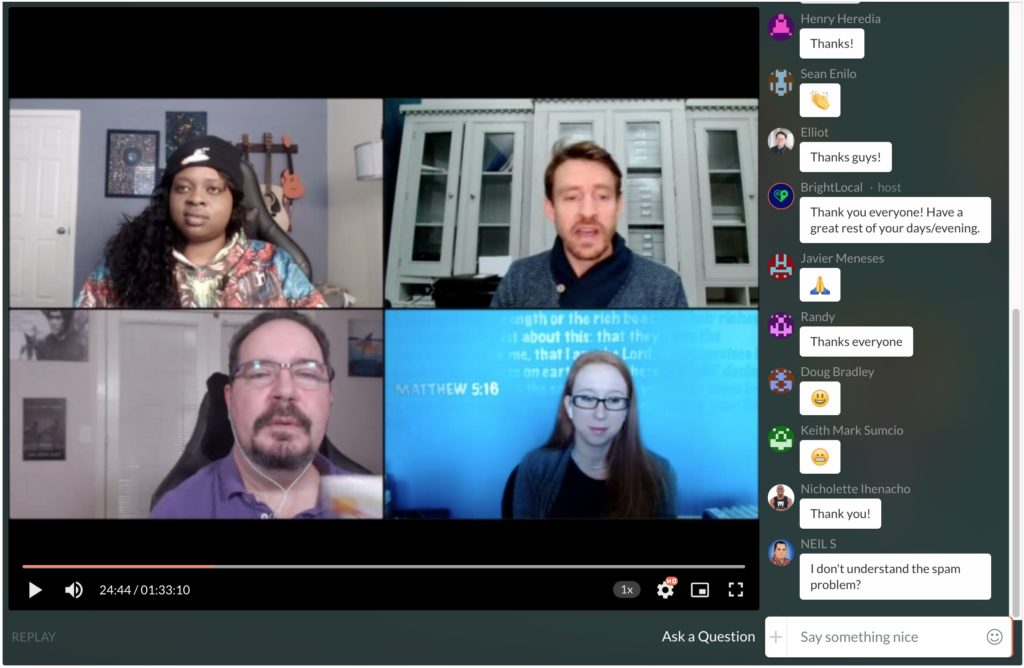Great to watch the Brightlocal “State of Local Search 2022” webinar last night, with some of the world’s leading local SEOs including Amanda Jordan of RicketyRoo and Ben Fisher of Steady Demand. These are some of my personal highlights and takeaways:
Always Experiment
It’s tempting to think there’s a “right way” to do SEO or Local SEO, but all the panelists agreed that things change quickly, received wisdom is often wrong and the only way to know what works and what doesn’t is to be constantly trying different things and measuring the results.
In these days of endless statistics and monitoring platforms this is easy to do. Set up useful analytics like your local search grid and positions for targeted keywords, then change one thing at a time and monitor the results. Don’t just Google “how to do xyz” and assume that the answer will be correct.
Optimising for “Near Me” Search
Along those lines, Joy Hawkings of Sterling Sky said they’ve had great results optimising for “near me” searches by simply including the words in the page, along with terms like “in the area”, “local to you” and so on. This was a surprise for me and for the rest of the panelists (and for Joy as well) because we thought Google stopped this trick working years ago. Keep an open mind, experiment, measure and see what works.
“Google is not your friend”
Like many SEOs I’m an avid follower of the Google Search Central Blog but was amazed to hear Ben Fisher say that “up to 60% of what Google say is misinformation”, and that this came from a Google employee.
We’ve all, including me, found that doing exactly what Google says doesn’t always lead to better rankings, and assumed there must be other factors involved, but Ben was sure about it. Don’t listen to Google. Experiment and do what works.
No-one speculated on the reasons for this, but I wonder if Google’s algorithms can’t keep up with their advice on making the web better. While they’re saying “write for humans” (for example), the AI is still not at the level where it really knows what is good writing, and some dirty tricks will still work better.
GMB for Location Research
With the ease of setting up a GMB and the immediacy of the data available as to how fertile the market is for your services in that area, the panelists reported that a lot of businesses are now using GMB for location research.
Let’s say I want to open a new branch for my business but don’t know which out of 4 or 5 locations would be best. I set up identical GMBs in all locations, monitor the local search grid of each and within a week I’ll have a clear picture of the market for my service in each area. Genius.
Ben Fisher also reported that some businesses are getting employees to set up GMB locations at their home addresses, potentially turning a single-location business into one with 20+ locations overnight and exponentially increasing their market share.
Ben also discussed how Google are getting wiser to shared office space being used for GMB locations – having banned all Regus office addresses from being used to create a GMB.
Optimising for Multi-Location Businesses
This is something close to my heart since I work for a lot of clients who have more than one business location and need to know the best way to optimise their website and GMB to handle multiple locations.
The short answer is of course, it depends. By all means create a page for each location, but whether to link each GMB to the individual location page or your homepage depends on how much authority you have for each, and how well you can reasonably optimise your homepage for all your various locations. If you have 2 locations you can probably do so easily. If you have 200 it’s impossible.
The plot thickens when you have medical practices with multiple practitioners (as with several of my Websites for Osteopaths clients) or the opposite – one practitioner who works in several locations. There are many factors to take into account such as who is going to own the reviews, and not saturating one location with GMBs with the same primary category.
All in all a nice webinar from BrightLocal and some useful takeaways for 2022.

